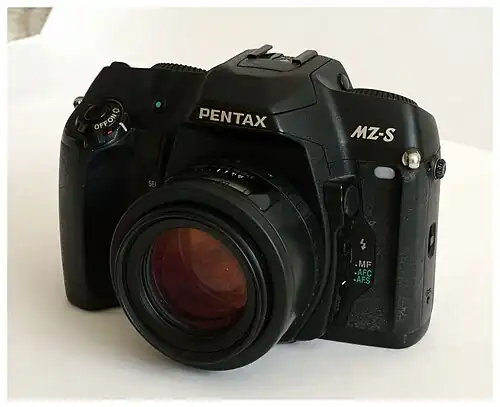Pentax MZ-S
 | |
| Overview | |
|---|---|
| Maker | Asahi Optical Co., Ltd. |
| Type | SLR |
| Released | 2001 |
| Production | 2001–2006 |
| Lens | |
| Lens mount | KAF2 |
| Sensor/medium | |
| Recording medium | 135 film |
| Film advance | Automatic |
| Focusing | |
| Focus modes | Autofocus Single, Autofocus Continuous, Manual Focus |
| Exposure/metering | |
| Exposure modes | Program, Aperture Priority, Shutter Priority, Manual |
| Exposure metering | TTL open-aperture 6-segment meter |
| Flash | |
| Flash | Retractible 24mm coverage, Guide number 12 at 100 ISO |
| Flash synchronization | 1/180 sec |
| Compatible flashes | Flashes with Pentax Proprietary Hotshoe |
| Shutter | |
| Shutter | Electronically controlled vertical focal-plane shutter |
| Shutter speed range | 1/6000 sec. - 30 sec |
| Continuous shooting | 2.5 fps |
| Viewfinder | |
| Viewfinder | Pentaprism |
| Viewfinder magnification | 0.75x |
| Frame coverage | 92% |
| General | |
| Battery | 2 x CR2 |
| Dimensions | 136.5 x 95.0 x 64.0 mm |
| Weight | 520g |
| Made in | |
The Pentax MZ-S is a 35mm single-lens reflex camera from Pentax of Japan. It was introduced in 2001[1] and discontinued in February 2006.[2] It is closely related to the prototype MZ-D Full-frame digital SLR, which never entered production.[3] It was the top-of-the-line model of Pentax's MZ/ZX series and replaced the PZ-1p as the high-end Pentax camera.[4] No camera was produced to replace the MZ-S, making it Pentax's last high-end 35 mm camera. The MZ-S is the last film camera from Pentax that was manufactured in Japan.
Design
.jpg)
The MZ-S was a "clean sheet of paper" design that re-thought most aspects of Pentax's camera interface and appearance.[5] Design goals included simpler operation, small size and light weight without sacrificing the sophisticated features required to be competitive. The MZ-S design returned to a more conventional one compared to the PZ-1p; the shoe for external flash and accessories returned to the top of the pentaprism housing, instead of the unusual right-handgrip position used on the older camera. The status LCD moved from atop the pentaprism to the top of the camera's right shoulder, like many competing designs. However, instead of a flat camera top, the Pentax designers angled the top plate towards the user at a 30° angle for easier viewing.
The camera featured an autofocus system based on six linear CCD sensors, on-film data recording and an MTF autoexposure mode which chooses the aperture for maximum sharpness.
See also
References
- ^ Pentax. "History of Innovations 2000-Present". Archived from the original on 2006-10-29. Retrieved 2006-09-18.
- ^ Grad, Orin (2006-02-12). "Pentax Holds a Product Massacre Too". The Online Photographer. Retrieved 2006-09-18. Cites Japanese-language sources.
- ^ "Pentax "MZ-S" Film SLR". Asahi Optical Historical Club. 2000-10-20. Archived from the original on 2004-05-30. Retrieved 2006-09-18.
- ^ Dimitrov, Bojidar. "Z-1p / PZ-1p". K-Mount Pages. Archived from the original on 2007-01-23. Retrieved 2006-09-18.
- ^ "MZ-S Story". Asahi Optical Historical Club. Archived from the original on 2006-10-04. Retrieved 2006-09-18.
External links
- "Introducing the MZ-S professional...the new flagship of the Pentax SLR line" (PDF). Pentax. Archived from the original (PDF) on 2003-12-16. Retrieved 2006-09-25.
- "Pentax MZ-S". Popular Photography & Imaging. November 2001. Archived from the original on March 4, 2009. Retrieved 2006-09-25.
- Fadner, W.L. (May 2002). "The Pentax MZ S Professional Camera". Shutterbug. Retrieved 2006-09-25.
- "Pentax MZ-S Operating Manual" (PDF). Pentax. 2004. Retrieved 2018-03-07.
- "Pentax MZ-S Film SLR Review]". Pentax User. 2002. Retrieved 2018-03-07.